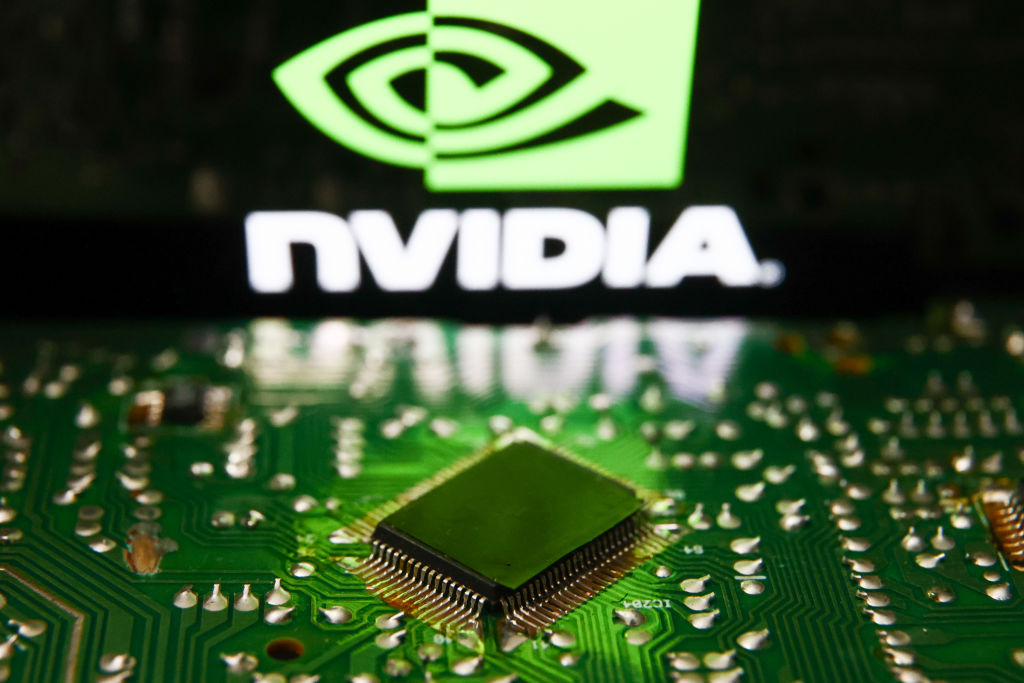Is Nvidia overvalued?
Nvidia is the world’s largest company and the first ever to be worth over $4 trillion. But despite being the undisputed leader in artificial intelligence, can it justify this valuation?


Nvidia has been one of the biggest success stories in the stock market over the past three years.
The company has become a favourite stock among DIY investors as well as institutional ones. Nvidia’s share price gained around 900% since the launch of ChatGPT in November 2022, while the semiconductor giant become almost synonymous with the artificial intelligence (AI) sector and become the world’s first $4 trillion company.
But these explosive gains, while they have been accompanied by similarly explosive earnings growth, have always attracted their share of scepticism. With detractors increasingly willing to vocalise the notion that the AI bubble could be set to burst, the idea that Nvidia might be overvalued is gaining traction.
MoneyWeek
Subscribe to MoneyWeek today and get your first six magazine issues absolutely FREE

Sign up to Money Morning
Don't miss the latest investment and personal finances news, market analysis, plus money-saving tips with our free twice-daily newsletter
Don't miss the latest investment and personal finances news, market analysis, plus money-saving tips with our free twice-daily newsletter
For context, Nvidia’s market cap as of 3 October is $4.6 trillion.
“That’s more than the whole of UK listed companies,” points out Karim Moussalem, CIO equities at Selwood Asset Management. “[Nvidia] is capable of adding hundreds of billions of dollars in market capitalization in a single trading day on the back of new product announcements or investment headlines.”
Nvidia trades at a price/earnings (P/E) ratio of around 54 times trailing earnings and around 30 times its projected earnings. These aren’t that out of the ordinary for big tech stocks, especially the Magnificent Seven that characterise the AI trade.
“I think it’s hard to argue that [Nvidia’s valuation is] completely crazy,” said Rob Perrone, investment specialist at Orbis Investments. “This company earns returns on capital of 70%, it’s been doubling revenues, Wall Street thinks it’s going to carry on growing at 30% for a long time.”
Where does Nvidia’s revenue come from?
You might ask: who cares if Nvidia is valued at more than the entire UK stock market? It generated nearly a third as much profit as the entire index did last year ($84 billion compared to the FTSE 100’s combined £192.9 billion, approximately $260 billion), and is growing substantially faster.
Nvidia is a huge business, and its revenue and profits have ballooned in recent years. But its revenue increases have come from a fairly clustered set of companies.
Two customers accounted for a combined 33% of Nvidia’s accounts receivable balance in its latest quarterly results.
Two customers (referred to in Nvidia’s reports as Customer A and Customer B) accounted for a combined 39% of Nvidia’s Q2 revenue (23% and 16% of revenues, respectively). In other words, almost a quarter of Nvidia’s revenue comes from a single customer, and two fifths is accounted for by its largest two.
This revenue concentration is increasing: in Q1, Customer A and Customer B accounted for 30% of revenue (16% from Customer A and 14% from Customer B).
Nvidia’s next four largest customers accounted for a combined 44% of revenue, meaning that six customers account for more than four fifths of all Nvidia’s revenue.
These ‘direct’ customers are likely to be original equipment manufacturers (OEMs) who buy up and distribute Nvidia’s chips, and as such might reflect a more diverse end-user base than the figures alone suggest. Even so, Nvidia’s chief financial officer, Colette Kress, said in her Q2 statement that large cloud service providers account for approximately 50% of Nvidia’s Data Center revenue (which itself was 88% of total revenue during the quarter).
As much as Nvidia itself appears to have a strong customer base that is increasing its spend, Perrone says that you have to look downstream in order to assess the long-term sustainability of the growth expectations baked into its valuation.
“Apart from Microsoft, it doesn't really seem like a lot of people have figured out how to make money off of this stuff yet,” he says.
Nvidia’s circular economy
The key question, then, is where Nvidia’s customers (direct or indirect) get their money from.
Moussalem draws attention to what he calls “a strikingly circular flow of capital”.
“Nvidia sells the chips that power OpenAI and other large model developers, helps finance their purchases through equity and structured deals, and then benefits as each new announcement of bigger training runs or data centre projects feeds the perception of limitless growth.”
Nvidia’s recent investment into OpenAI, for example, will see it buy additional equity in the ChatGPT maker for every gigabyte of Nvidia hardware OpenAI deploys.
FT Alphaville arguably summarised the deal best as such:
“How much of the $100bn would be flowing back to Nvidia in revenue from chip sales?
"Dunno.”
Coreweave, which IPOed earlier this year, is another case in point. It buys up Nvidia GPUs, then leases them out to companies (including Nvidia) that want to temporarily boost their computing resource. Nvidia reportedly owns a $2 billion stake in Coreweave. The upshot is that Nvidia is a supplier to, customer of and investor in Coreweave all at the same time.
“Every press release drives the stock higher, which in turn supports additional capital raises and even larger spending commitments,” said Moussalem. This, he said, creates “a powerful feedback loop that looks less like traditional business and more like late-cycle financial engineering. You can also call it vendor financing, or a Ponzi scheme.”
Perrone is more reserved, but even he describes the merry-go-round of capital between AI’s major players as “not the most sustainable source of financing”.
“Ultimately, you need money coming in from customers, from outside the ecosystem,” he told MoneyWeek.
Could Nvidia’s share price fall?
The situation, says Moussalem, is “eerily reminiscent of the late-1990s dotcom boom.”
That boom was underpinned by a widespread belief in endless growth that came abruptly to a halt.
Should one of the big cloud service providers decide that pouring money into AI infrastructure is no longer worthwhile, Nvidia’s revenue risks falling off a cliff. For now, there’s no reason to think they have any intention of doing so imminently.
There are, though, early indicators around that might eventually change that perception. The economics of AI look precarious at present. Bain & Co’s 2025 Technology Report forecasts that by 2030, AI companies will need to generate $2 trillion in revenue in order to fund projected data centre buildout, but that the anticipated productivity gains that AI is expected to yield would still fall $800 billion short of this total.
It should be remembered that while Nvidia and the cloud hyperscalers are (highly) profitable businesses, the AI developers paying them aren’t. OpenAI, Anthropic and most other AI start-ups are still giving most of their hugely cost-intensive products away for free in order to drive adoption.
“OpenAI is burning cash,” says Perrone. “When Meta (then Facebook) had [as many customers as OpenAI currently does] it was printing cash.
“To justify the scale of investment going in, you need gigantic numbers – revenue not in the hundreds of billions, but more like the trillions,” Perrone adds.
Paying customers (that is, enterprises) need to increase rapidly over the next five years or so to make AI viable. But why should they, given that according to a recent MIT report 95% of businesses spending money on AI aren’t seeing a return?
Ultimately, this is a big stack of cards that Nvidia’s present valuation is built on top of. The assumption is that it will keep increasing its profits rapidly into the foreseeable future.
“When expectations are high, so is risk,” said Perrone in an article on the quiet winners of AI competition.
Moussalem believes that “we are in the midst of a bubble, and a total retail-driven frenzy”.
And while Perrone is more circumspect, he believes “there are better opportunities” and better ways for investors to play the AI theme than to buy Nvidia shares. Some of these ideas were highlighted in MoneyWeek magazine here: Buy the ammo-makers: how to find value in the AI wars.
Get the latest financial news, insights and expert analysis from our award-winning MoneyWeek team, to help you understand what really matters when it comes to your finances.

Dan is a financial journalist who, prior to joining MoneyWeek, spent five years writing for OPTO, an investment magazine focused on growth and technology stocks, ETFs and thematic investing.
Before becoming a writer, Dan spent six years working in talent acquisition in the tech sector, including for credit scoring start-up ClearScore where he first developed an interest in personal finance.
Dan studied Social Anthropology and Management at Sidney Sussex College and the Judge Business School, Cambridge University. Outside finance, he also enjoys travel writing, and has edited two published travel books.
-
 Salary sacrifice pensions cap: 3.3 million workers to be hit by contribution limits
Salary sacrifice pensions cap: 3.3 million workers to be hit by contribution limitsThe government has revealed further details of its controversial cap on pension contributions through salary sacrifice. Here is how the changes could affect you
-
 Suffering from home bias? Try Asia and its smaller companies
Suffering from home bias? Try Asia and its smaller companies
-
 Which sectors are best to invest in for 2026?
Which sectors are best to invest in for 2026?Investment trust portfolio managers give their views on the sectors and regions they expect to outperform in 2026.
-
 ChatGPT turns three: what’s next for the ‘AI era’?
ChatGPT turns three: what’s next for the ‘AI era’?Three years after its launch kickstarted the age of AI, ChatGPT and its maker OpenAI are driving the stock market. But concerns are growing over whether OpenAI will be able to turn its AI dominance into profit.
-
 Big Short investor Michael Burry closes hedge fund Scion Capital
Big Short investor Michael Burry closes hedge fund Scion CapitalProfile Michael Burry rightly bet against the US mortgage market before the 2008 crisis. Now he is worried about the AI boom
-
 The global defence boom has moved beyond Europe – here’s how to profit
The global defence boom has moved beyond Europe – here’s how to profitOpinion Tom Bailey, head of research for the Future of Defence Indo-Pac ex-China UCITS ETF, picks three defence stocks where he'd put his money
-
 New frontiers: the future of cybersecurity and how to invest
New frontiers: the future of cybersecurity and how to investMatthew Partridge reviews the key trends in the cybersecurity sector and how to profit
-
 Canada will be a winner in this new era of deglobalisation and populism
Canada will be a winner in this new era of deglobalisation and populismGreg Eckel, portfolio manager at Canadian General Investments, selects three Canadian stocks
-
 Jim O’Neill on nearly 25 years of the BRICS
Jim O’Neill on nearly 25 years of the BRICSJim O’Neill, who coined the acronym BRICS in 2001, tells MoneyWeek how the group is progressing
-
 Nvidia earnings beats expectations
Nvidia earnings beats expectationsNvidia’s earnings beat has reassured the market about the strength of demand for AI infrastructure